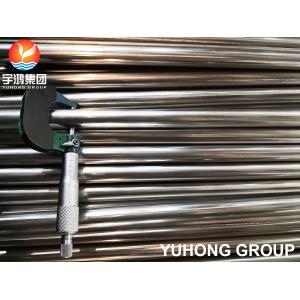
Add to Cart
Abstract of ASTM A249
This guide specifies standard specification for nominal-wall-thickness welded tubes and heavily cold worked welded tubes made from the austenitic steels with various grades intended for such use as a boiler, superheater, heat exchanger, or condenser tubes. Heat and product analysis shall conform to the requirements as to chemical composition for carbon, manganese, phosphorous, sulfur, silicon, chromium, nickel, molybdenum, nitrogen, copper, and others. All materials shall be furnished in the heat-treated condition in accordance with the required solution temperature and quenching method. When the final heat treatment is in a continuous furnace, the number of tubes of the same size and from the same heat in a lot shall be determined from the prescribed size of the tubes. The material shall conform to the prescribed tensile and hardness properties such as tensile strength, yield strength, elongation, and Rockwell hardness number. The steel shall undergo mechanical tests such as tension test, flattening test, flange test, reverse-bend test, hardness test, and hydrostatic or nondestructive electric test. The grain size of different grades of steel shall be determined in accordance with the test methods.
Weld tube characteristics:
Production characteristics: Lightweight production equipment, low investment, fast building material speed, simple welding method, wide product specification range, high dimensional accuracy, small wall thickness deviation, smooth surface, and high yield. In mass production, the cost of welded pipes is more than 20% lower than that of seamless pipes.
Advantages: During the production process, stainless steel welded pipes are uniformly squeezed and then subjected to online bright solution annealing, resulting in a very smooth surface. A smooth surface is not easy to scale and has the function of preventing scaling. This is beneficial for heat dissipation and does not require frequent cleaning, saving time, effort, and money. Secondly, when welding pipes, the advantage of uniform wall thickness in the deep processing of sheet metal products is relatively good, and it can also be arbitrarily sized with high accuracy. Once again, stainless steel material has the characteristic of corrosion resistance and has a longer service life.
Specification
ASTM A249/A249M-18a Standard Specification for Welded Austenitic Steel Boiler, Superheater, Heat-Exchanger, and Condenser Tubes
| Specifications | ASTM A213, A249, A270, A269 / ASME SA213, SA249, SA270, A269 |
| Standard | ASTM, ASME and API |
| Seamless Tubes Range | 1/2"OD - 12"OD |
| Welded Tubes Range | 1/2"OD - 12"OD, Guage: 25 SWG - 10 SWG |
| Outside Diameter | 3.00 mm - 219.10 mm, 6.35 mm O.D to 114.3 mm O.D |
| Length | Single Random, Double Random & Required Length |
| Thickness | 0.40 mm - 12.70 mm, 0.8 mm to12.7 mm |
| Schedule | SCH20, SCH30, SCH40, STD, SCH80, XS, SCH60, SCH120, SCH140, SCH160, XXS |
| Type | Seamless, Welded, ERW |
| Form | Round Tubes, Square Tubes, Rectangular Tube |
| End | Plain End, Beveled End, Treaded |
SS316L Equivalent Grades
| STANDARD | WERKSTOFF NR. | UNS | JIS | BS | GOST | AFNOR | EN |
| SS316L | 1.4404 / 1.4435 | S31603 | SUS 316L | 316S11 / 316S13 | 03Ch17N14M3 / 03Ch17N14M2 | Z3CND17‐11‐02 / Z3CND18‐14‐03 | X2CrNiMo17-12-2 / X2CrNiMo18-14-3 |
Chemical Composition
| Grade | C | Mn | Si | P | S | Cr | Mo | Ni | N | |
| SS316L | min. max. | - 0.03 | - 2.0 | - 0.75 | - 0.045 | - 0.03 | 16.0 18.0 | 2.00 3.00 | 10.0 14.0 | - 0.10 |
Mechanical Properties
| Grade | Tensile Strength (MPa) min | ield Strength 0.2% Proof (MPa) min | Elongation (% in 50mm) min | Hardness | |
| Rockwell B (HR B) max | Brinell (HB) max | ||||
| 316L | 485 | 170 | 40 | 95 | 217 |
Physical Properties
| Grade | Density (kg/m3) | Elastic Modulus (GPa) | Mean Co-eff of Thermal Expansion (µm/m/°C) | Thermal Conductivity (W/m.K) | Specific Heat 0-100°C (J/kg.K) | Elec Resistivity (nΩ.m) | |||
| 0-100°C | 0-315°C | 0-538°C | At 100°C | At 500°C | |||||
| 316L | 8000 | 193 | 15.9 | 16.2 | 17.5 | 16.3 | 21.5 | 500 | 7 |
Applications
